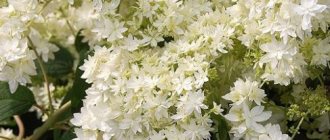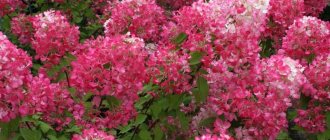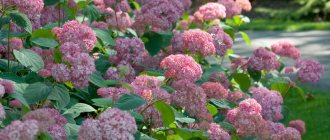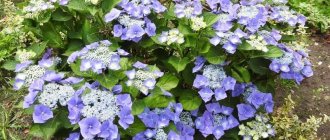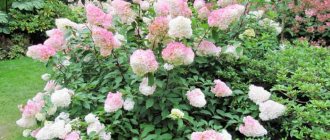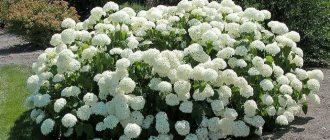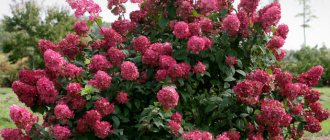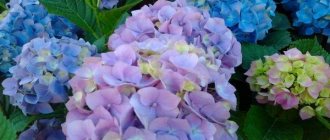Natalya Popova Grows hydrangea in her dacha
Tree hydrangea Annabelle is a low tree-like shrub with spreading side shoots and incredibly beautiful, large spherical inflorescences. What else is remarkable about the Anabelle hydrangea and how to care for the plant - I’ll tell you about it.
| Hydrangea Anabelle | |
| general characteristics | Low tree-like shrub with spreading lateral shoots |
| Size | Height up to, cm: 150 Width up to, cm: 300 |
| Flowers | Small up to 2 cm, collected in spherical inflorescences |
| Leaves | Rich emerald color, oval shape with pointed tips |
| The soil | Rich chernozem soils, with good drainage and the presence of constant moisture |
| Illumination | Sun, partial shade |
| Winter hardiness | Frost-resistant |
Description of hydrangea variety Anabel
The shrub has a dome-shaped shape. The height of the tree hydrangea Anabel is up to 1.5 m, the width of the bush is up to 2-3 m in diameter. The leaves of the plant are oval, up to 20 cm in length, with pointed tips and jagged edges. The leaf blades grow very densely, and the dark green color is retained almost until winter arrives - this is one of the main advantages of the variety.
Anabel is valued for her huge spherical inflorescences
Anabelle is especially appreciated for its beautiful flowering. In mid-summer, in July, it produces small flowers collected in large spherical inflorescences up to 25 cm in diameter. At the beginning of flowering, the inflorescence balls are light green in color, but then they acquire a bright white color and remain that way until autumn.
Important! There is also a subspecies of the Anabel Pink hydrangea variety. The bushes are almost identical to each other, and the only difference is the shade of the flowers - Anabel Pink's are pink.
Anabel Pink is a variety of the variety, but not with white, but with pink flowers
The spherical hydrangea Anabel can become a long-liver in the garden; its life cycle lasts about 45 years. The plant develops quite quickly, annual growth can be up to 20 cm.
The need for feeding
Some gardeners do not fertilize regularly. And the hydrangea develops and blooms well. But impressive sizes of bushes and flowering caps are not expected in this case.
Feeding during the season takes place in several stages.
- In early spring, before mulching the soil, fertilizer is applied under the roots for intensive growth. It should be dominated by microelements such as phosphorus, potassium and nitrogen.
- During the formation of inflorescences, a second feeding is carried out, based on the content of phosphorus and potassium.
- In spring, you can spray the plant 2-3 times with a solution of potassium permanganate. This increases the strength of the shoots, which is extremely necessary for hydrangea. Under the weight of the buds, the branches bend towards the ground.
Some try to tie branches to a support. But this action completely changes the greatness of the bush.
Hydrangea tree Annabelle in landscape design
Gardeners love Annabelle because this shrub looks attractive in almost any landscape. A low, but very spreading and dense plant is used:
- for creating single compositions;
- as an element of group plantings;
- in the form of an unusual hedge;
- for decorating empty corners of the garden, for example, areas near walls and fences.
Hydrangea Anabel blooms until late autumn and produces beautiful and bright white flowers. She continues to decorate the garden when all other plants have already finished flowering and even fly away before the approaching winter. Hydrangea looks attractive against the background of coniferous plants; large white inflorescences emphasize the rich, deep green of conifers.
The plant can completely transform the garden landscape
Application
Because of its lush growth, tree hydrangea looks best in large gardens and landscaped parks, planted solo against the background of a dark fence or green lawn. Low varieties are excellent for growing in small garden plots. The shrub goes well with other types of hydrangeas (paniculate, large-leaved and rough), creating beautiful and original compositions with them. Can be planted in combination with smaller plants that prefer semi-shaded areas, ferns and hosta. Hydrangeas make stunning, informal hedges, suitable for large gardens or large spaces. After flowering, the inflorescences remain on the shoots for a long time; after drying, they form an original winter garden decoration. The inflorescences are suitable for dry bouquets.
Planting and caring for Annabelle tree hydrangea
The hardy shrub does not have too strict care requirements. But it is necessary to become familiar with the rules for growing the variety in order to provide Anabel with comfortable conditions.
For the plant you need to choose a sunny but slightly shaded place
Selection and preparation of a landing site
It is best to plant tree-like Anabelle in the spring, so that the plant is guaranteed to have time to adapt to the site before the onset of winter cold. The place for hydrangea is chosen to be sunny, but with light shading - Anabel loves light, but does not tolerate the scorching sun. You can plant shrubs under the cover of a house wall or next to tall trees. But at the same time, it is important to ensure that they do not take away moisture from the hydrangea, otherwise the plant will always lack nutrients.
In the selected area for hydrangea, dig a planting hole - about 50 cm deep and 40 cm wide. Anabel prefers fertile soils, so humus and peat are added to the extracted soil in equal parts. You also need to add sand to the soil mixture; it will make the soil looser and provide good drainage.
Hydrangea loves moisture, but swampy soil is harmful to it. Therefore, when planting, you need to ensure that drainage water passes deep enough, no closer than 1.5 m to the soil surface.
The shrub loves moisture, but the soil should not be swampy
How to plant hydrangea Anabel
Immediately before planting, the seedling is briefly immersed in water with a solution of potassium permanganate added to it. This will saturate the roots with moisture and at the same time disinfect them.
The landing algorithm looks like this:
- the planting hole is filled halfway with prepared nutrient soil, forming a small mound;
- the Anabel seedling is lowered into the prepared hole and the roots of the plant are straightened so that they lie neatly on the sides of the earthen mound;
- the remaining soil is poured into the hole, filling it entirely to the surface of the ground - the root collar of Anabel should rise slightly above the ground;
- The soil is lightly compacted so that it does not sag, and the young plant is watered abundantly.
Immediately after this, the tree trunk circle is mulched with a dense layer, otherwise the moisture will evaporate too quickly.
Typically, several bushes are planted on a site to form a decorative composition. The distance between individual plants should be at least 2 m; the gardener needs to remember that the bush grows greatly in width.
Advice! When preparing the planting hole and during planting, you should not add lime or wood ash to the ground; they alkalize the soil, which is very harmful to the plant.
The plant can be planted either in groups or alone
Watering and fertilizing
Tree hydrangea Annabelle loves moisture, but despite this, it is a drought-resistant plant. In the hot summer, it can patiently wait for watering without falling off or dying from lack of moisture. Still, it is recommended to water the shrub regularly, in which case the hydrangea will always be green and beautiful.
Watering is carried out in accordance with weather conditions. With the onset of spring and after the snow melts, you need to ensure that the soil in the tree trunk does not dry out. It is recommended to keep the soil slightly moist for Anabelle, and you need to especially carefully control the amount of moisture during flowering. During this period, the plant needs maximum nutrition and nutrients.
It is recommended to water young plants more often during the period of active development. Hydrangea grows shoots and green mass, and sufficient water stimulates it to grow well.
As for fertilizing, they are not strictly necessary. But if you want to grow a truly spreading and abundant flowering plant in the garden, then you should fertilize Anabel several times a season.
Feeding schedule:
- The first feeding is traditionally carried out in early spring, even before the start of the growing season. Complex minerals - phosphorus, potassium, nitrogen - are added to the soil. The last element is especially important in spring for hydrangeas, as it stimulates the growth of shoots and leaves.
- The second time the bush is fed just before the buds open. During this period, it is necessary to add phosphorus and potassium to the soil; they will increase the plant’s endurance and ensure long and beautiful flowering.
- In the summer, Anabel needs to be fed once a month; you can use nitrophoska, diluted manure or chicken droppings, as well as complex minerals. Fertilizers will help prolong flowering and preserve the beauty of the plant until autumn.
Fertilizers provide the plant with more abundant flowering
In addition, in the summer it is recommended to treat Anabel with a solution of potassium permanganate; the product will prevent the bush from becoming infected with fungal diseases.
Hydrangea is also fertilized in the fall. During this period, it is best to fertilize the bush with potassium and phosphorus, as well as organic matter - peat and humus. But nitrogen can no longer be added in the fall; it stimulates growth processes, which the plant does not need at all before wintering.
How to Prune Annabelle Hydrangea
In landscape design, it is customary to trim hydrangea regularly; without pruning, Anabel grows too chaotically and loses its neat silhouette. The procedure is carried out in the spring, before the start of active growing season - the hydrangea shoots are cut by about 15 cm or by a third, giving it an aesthetic dome-shaped shape.
Pruning is needed not only to maintain the silhouette, but also to maintain abundant flowering. If Anabel grows too much, her flowers gradually become smaller and less lush.
Important! Pruning of Anabel hydrangea can only be done from the fourth year of life. Younger shrubs cannot be trimmed.
In the autumn, you can additionally carry out sanitary pruning. During the procedure, all dried and broken shoots of the bush are cut off. After pruning in the fall, the Anabelle hydrangea will survive the winter more easily and begin active growth in the spring.
In autumn, it is customary to prune shrubs from dry and weak branches.
Shelter for the winter of hydrangea Anabel
An adult tree-like shrub tolerates even very low temperatures. However, a young plant may suffer from frosts below - 20 °C. Therefore, when growing Anabel hydrangea in the Urals and other cold regions in the first years, it is advisable to cover it with the onset of winter.
At the end of autumn, shortly before the cold weather, the shrub is freed from dried stems and remaining leaves, and then the ground in the tree trunk is densely mulched with sawdust, organic fertilizers or pine needles. The branches of the plant can be bent to the ground and fixed so that Anabel does not break under the weight of the snow. If the wintering of the Anabelle hydrangea is very cold, you can additionally cover the bush with non-woven material or spruce branches.
Transplantation after purchase into open ground
Hydrangea Levana paniculata - description
Before you start planting seedlings, you should familiarize yourself with the recommendations of experienced gardeners regarding planting. The first step is to choose the place where the bush will be planted. After this, you can start preparing the soil.
Selection of location
First of all, you need to think about the place in which one or more hydrangea shrubs will grow. It is unacceptable to give preference to areas with frequent drafts. Despite the fact that the plant is heat-loving, it is better to plant it in the garden in partial shade, since direct sunlight on the foliage provokes burns. Frequent and abundant watering will help the shrub to withstand a prolonged period of drought.
Suitable soil
It is unacceptable to contain even a small amount of chalk and lime in the perennial soil. It is best to use fertile soil with a good drainage layer and the presence of moisture for planting the Anabel variety. If the soil is too dry, the bush will grow slowly. Lush flowering in this case cannot be expected.
Planting a tree shrub
Step by step planting process
Planting and caring for Annabelle hydrangea (Hydrangea Arborescens 'Annabelle' in Latin) outdoors is not difficult. It is best to choose two- and three-year-old seedlings in a tube for planting on your own plot. It is better to postpone the process of planting until the end of April or the beginning of May, when the threat of winter frosts has passed. If planting is still done in the fall, the root system must be insulated.
- Dig a square hole 50-60 cm deep in the selected location.
- Pour a drainage layer based on broken bricks, crushed stone and gravel onto the bottom. The thickness should be within 7 cm.
- The root system of the plant is placed in the recess and carefully straightened out.
- Fill the voids with soil. It is advisable to fill it with soil prepared by yourself. For this purpose, combine the excavated soil with a small amount of sand and sawdust.
- The soil is filled up to the root collar of the plant.
- Water the soil generously where the white Anabelle hydrangea is planted. It is advisable to pour at least 15 liters of settled rainwater under each bush.
Note! Following the recommendations regarding planting and caring for shrubs will allow you to enjoy lush flowering next year.
Propagation of hydrangea Anabel
The shrub looks so attractive on the site that many gardeners sooner or later have a desire to increase the number of plantings. To do this, it is not necessary to buy seedlings; hydrangea reproduces well by vegetative methods if you have an adult healthy bush:
- Cuttings. At the very beginning of spring, the tops of young shoots of shrubs are cut off by about 15 cm and placed in water for germination for 2 weeks. When the cuttings take root, they can be planted in small containers with standard hydrangea soil and grown indoors at a temperature of about 22 ° C for another 2 years. When the sprouts turn into real healthy seedlings, they can be transferred to an area under the open sky.
- Layerings. In the spring, during the period of swelling of the buds, one of the lower branches of the bush is bent to the ground, slightly buried in the ground in the middle part and fixed so that the shoot does not straighten. The soil is constantly kept moist; with proper watering, the cuttings will produce roots by the beginning of autumn. Hydrangea Anabel is transplanted to a separate place after a year.
It is best to propagate the variety by layering and cuttings
Attention! You can also propagate Anabelle hydrangea by dividing the bush, but this method is rarely used. When dividing the rhizome of a shrub, there is a risk of injuring its main part too much and destroying the plant.
Why doesn't it bloom
If the bush does not bloom, then there are reasons for this:
- shoots were pruned incorrectly in April;
- insufficient watering and nutrition;
- the roots of the plant are underdeveloped;
- Flowering was artificially stimulated in the nursery. Due to the addition of this kind of product, hydrangea may not bloom for years. To resume the flowering process, it is necessary to continue treatment with a growth stimulator;
- Tissue death occurred due to too severe frost.
But if the shrub is already blooming, then you need to know about the slight difference in the plant. Representatives of this variety can change the shade of flowering . To get this effect, you just need to add drugs that change the pH of the soil. By absorbing coloring elements, they spread throughout the tissues and affect the pigmentation of the petals.
Important! To get blue instead of white, you will need to add products that contain aluminum to the soil.
Diseases and pests of hydrangea Anabel
Tree hydrangea is considered a fairly hardy plant; it rarely suffers from diseases. But sometimes it is still affected by fungal diseases, for example, powdery mildew or chlorosis. Diseases can be recognized by changes in the color of the leaves: first the foliage turns pale, and then begins to turn yellow and fall off, the flowering of the bush is disrupted.
Diseases affect hydrangea most often when grown on alkaline soil or in conditions of severe waterlogging. Therefore, the first step is to review the care of the plant and provide it with comfortable conditions. Shrub ailments are treated with standard fungicidal preparations, for example, a weak solution of potassium permanganate.
Of the pests for Anabel hydrangea, the spider mite is especially dangerous, the appearance of which can be recognized by the presence of thin white cobwebs on the leaves. You can get rid of insects by spraying hydrangea with soapy water or copper sulfate. Even for a healthy plant, it is recommended to carry out preventive spraying; it will prevent infection.
The shrub rarely suffers from pests, but preventive treatments will not harm it
Mulching the plant
An integral part of caring for tree hydrangea is mulching, which helps the plant not to overheat on hot days. In addition, this helps to get rid of weeds, which take excess moisture from the soil.
Mulching is done by placing a layer of peat under the bush. The layer should be no more than 20 centimeters. Organic compost and sawdust can also be used.
Results
Anabel is a unique representative of the Hydrangeaceae family. It is capable of changing the color of the petals, at the request of the gardener. As a result, the same bush will delight you in different ways.
Experienced flower growers know that Anabel easily absorbs coloring elements, which are reflected in the color of the petals. For example, to get blue hydrangea you need to acidify the pH of the soil to a level of 5.5 with preparations containing aluminum.
Hydrangea Anabelle will perfectly decorate the landscape design of any garden and yard. Both in a single version and in composition with other bushes. And you can admire its long flowering all season long.
